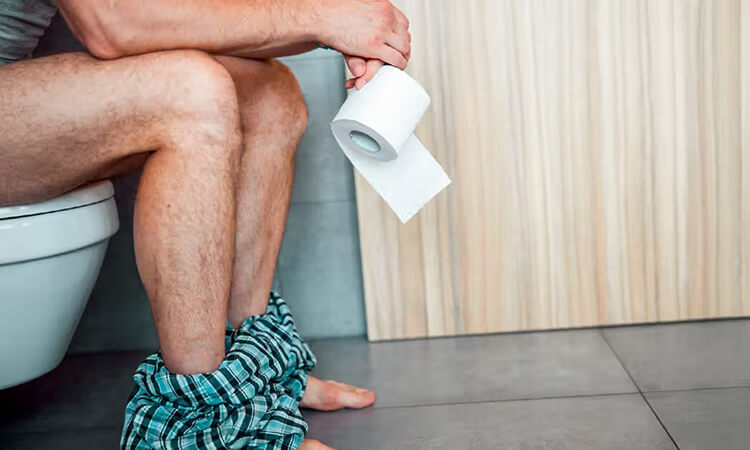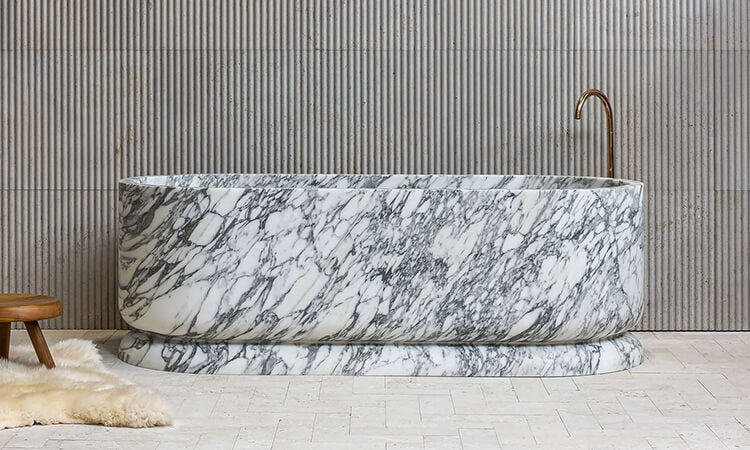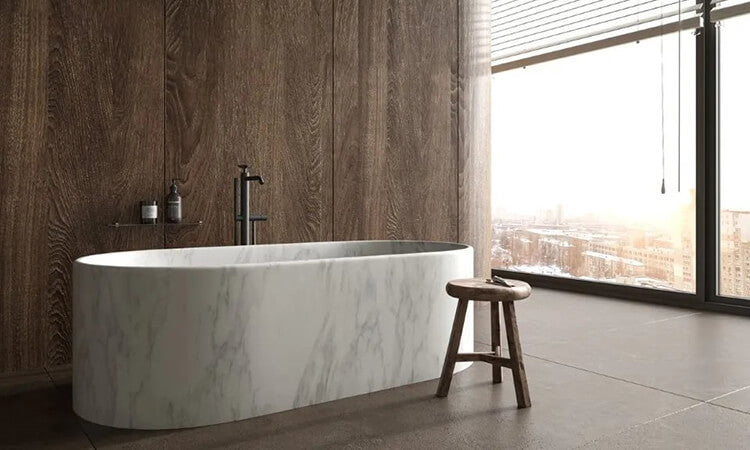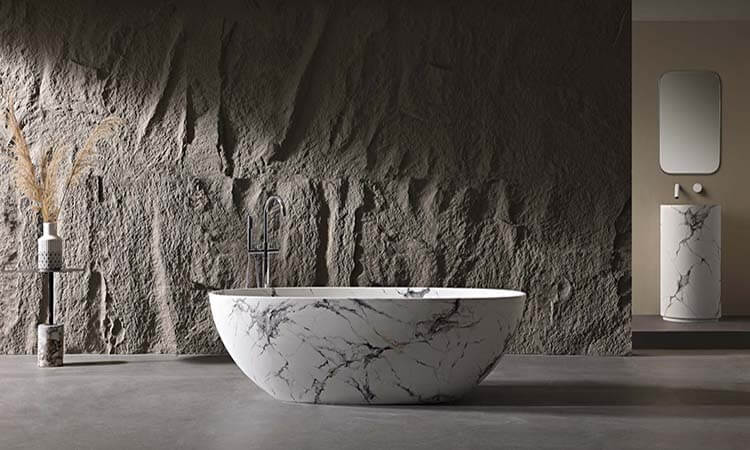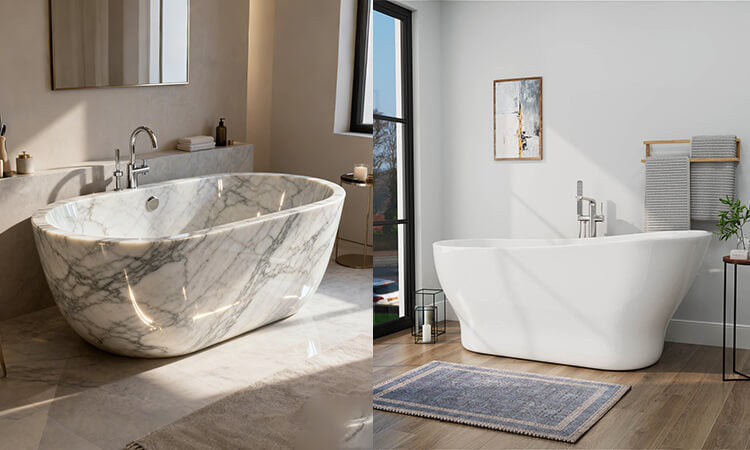The bathroom is easily the most humid room in any home, and your vanity—being the hub of daily activity—is constantly exposed to water, steam, and splashes. Over time, this exposure can cause cabinet boards to warp, countertops to crack, and hardware to rust. Many people think, “If it breaks, I’ll just replace it,” but neglecting regular care can significantly shorten your vanity’s lifespan. In this guide, we’ll show you simple, practical ways to protect your vanity from water damage—tips that are easy to follow, even if you’re new to home maintenance.
Choose the Right Base: Protect Your Vanity from the Start
Preventing water damage begins the moment you select your vanity. Different materials vary widely in water resistance, and choosing the right one can save you a lot of headaches down the road—up to 80% of future issues, in fact.
Countertop Materials: Go for Water-Resistant Surfaces
- Quartz: Highly recommended! Quartz countertops are made of over 90% quartz crystals, forming a dense, non-porous surface that resists water, stains, and cleaning agents. Quartz is also very hard, making it scratch-resistant. Just remember to properly seal the seams to prevent moisture infiltration.
- Sintered Stone: Offers performance comparable to quartz, and its ultra-thin, lightweight slabs are perfect for modern, minimalist bathrooms. For durability, choose slabs at least 12mm thick to avoid cracking under stress.
- Ceramic / Engineered Stone: Ceramic countertops are molded in one piece, providing excellent water resistance, though they can be heavy and fragile. Engineered stone is budget-friendly but may yellow over time with prolonged exposure to hot water; regular waxing and maintenance are recommended.
- Avoid Pitfalls: Natural marble is generally not the best choice. Its microscopic pores can absorb liquids like tea, cosmetics, or other stains if not properly sealed, and prolonged exposure to water may eventually damage the surface.
Cabinet Materials: Don’t Go “Naked” with Wood
- Recommended: Plywood with waterproof edge sealing, PVC panels, or stainless steel cabinets. Stainless steel is the most water-resistant but has an industrial look; plywood offers a balance of aesthetics and practicality and remains the mainstream choice.
- Avoid: Solid wood cabinets without waterproof treatment and particleboard cabinets. Solid wood can warp easily when exposed to moisture, while particleboard tends to swell and deteriorate with water exposure.
Daily Habits: 3 Simple Ways to Reduce “Active” Water Damage

Not all water-related problems are caused by natural aging—many result from daily habits. Adopting these three simple practices can help protect your vanity from water damage right at the source.
Control Water Accumulation
Wipe down countertops and sink edges immediately after use, paying special attention to faucet bases and the seams where the sink meets the wall. These “dead corners” are prime spots for grime and mold buildup.
Avoid leaving open cups, wet towels, or toiletries on the countertop. Instead, use racks or trays with drainage features so water can flow away naturally rather than pooling.
For undermount sinks, check the area beneath the drain for standing water. Regularly wipe it with a sponge to prevent prolonged moisture from affecting the cabinet.
Standardize Water Usage
Avoid pouring large amounts of hot water directly into the sink and leaving it standing. Excessive steam and high temperatures can accelerate countertop aging and compromise cabinet edge seals—especially with engineered stone or wood surfaces.
When washing your hair or face, try to minimize splashing onto the cabinet. Installing a simple silicone water barrier along the sink edge is an easy, clean, and highly effective solution.
Also, avoid pouring strong alkaline cleaners, like laundry detergent or dish soap, directly onto the countertop. If spills happen, rinse immediately with water to prevent chemical corrosion.
Ensure Proper Ventilation
After each use, run your bathroom exhaust fan for at least 15 minutes to remove excess moisture. If your bathroom doesn’t have a fan, open a window to maintain airflow.
During particularly humid periods, such as rainy seasons, place moisture-absorbing packets or activated charcoal inside the cabinet. For stubborn residual humidity, a cold-air setting on a hairdryer for 1–2 minutes can also help keep surfaces dry.
Structural Protection: Reinforce 4 Key Areas
Water damage often strikes at seams, hardware, or drainage points. Focusing on these vulnerable areas can significantly extend the life of your vanity.
Seams: Sealant as Your First Line of Defense
The junctions between the countertop and wall, or the sink and countertop, are prone to water intrusion. Inspect your sealant at least once a year and replace it if it’s blackened, cracked, or peeling.
When reapplying, remove old sealant completely and use a neutral silicone waterproof sealant (avoid acidic types, which can corrode metal and emit strong odors). Apply evenly and keep the area dry for at least 24 hours.
For extra protection and a cleaner look, you can cover the sealant edges with waterproof masking tape to reduce aging and improve aesthetics.
Hardware: Protect Against Rust and Moisture
Wipe faucets and drains weekly with a soft cloth dampened in warm water to prevent mineral buildup. A thin layer of petroleum jelly can act as a protective coating against rust.
Check faucet base seals regularly. Replace any worn gaskets immediately to prevent water from seeping into the cabinet. Wrap drain pipe joints with waterproof tape and inspect for cracks on a routine basis.
Cabinet Bottom: Create a “Water Barrier”
For floor-standing cabinets, attach waterproof rubber strips at points of contact with the floor to block rising moisture.
Seal any spots where pipes penetrate the cabinet with silicone to prevent condensation damage. Lining drawer bottoms with waterproof mats can also protect against splashes from toiletries.
Countertop Edges: Install a Splash Guard
A 2–3 inch (5–8 cm) splash guard along the countertop near the wall can prevent water from reaching the cabinet or wall. If possible, match the splash guard material to the countertop, and ensure seams are properly sealed if different materials are used.
Emergency Handling and Repairs
Even with the best precautions, small water-related issues can still occur. Addressing them promptly helps prevent bigger, more costly problems down the line.
Water Stains on Countertops
- Quartz or Sintered Stone: Wipe the surface with a soft cloth dampened with a small amount of white vinegar, then rinse thoroughly.
- Ceramic: Gently polish the stain using a small amount of toothpaste on a soft cloth.
- Engineered Stone: Apply a specialized stone care solution, let it sit for about 10 minutes, then wipe clean to reduce marks.
Minor Cabinet Moisture
If the cabinet surface swells slightly, blot it immediately with a dry towel and use a cold-air hairdryer to dry the area. Avoid hot air, which can cause cracking.
For small mold spots inside the cabinet, wipe the area with a diluted disinfectant solution (1 part disinfectant to 10 parts water), rinse with clean water, and let it dry completely. Using moisture-absorbing packets can help prevent future problems.
Moldy Seams
If sealant becomes moldy, carefully scrape it off with a utility knife. Wipe the seam with alcohol to kill remaining spores, let it dry completely, and then apply fresh waterproof sealant.
Ending
Water damage in bathroom vanities usually results from a combination of prolonged moisture exposure and a lack of proper protection. Instead of waiting for costly repairs or replacements, focus on choosing the right materials, practicing good daily habits, and maintaining critical areas regularly.
Remember, effective water protection doesn’t mean avoiding all contact with water—it means preventing water from accumulating over time. By following these steps, you can keep your vanity looking great and functioning properly for ten years or more, saving both money and hassle in the long run.


